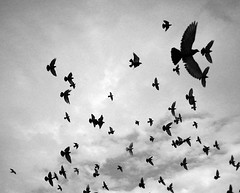Anne Lamott. Bird by Bird: Some Instructions on Writing and Life. Random House, 1994.
Perhaps you know this book already. If you’re a writer, chances are it’s been recommended to you, or you’ve come across it on lists of good books on writing. I know this, because it’s been on my horizon for years. I finally decided to familiarize myself.
I read my tattered second-hand copy this week while navigating through contract negotiations for my second book. (Because of this, Lamott’s description of a New Yorker cartoon struck me as particularly funny: “We’re still pretty far apart,” says a writerly type to a ‘normal’ person at party. “I’m looking for a six-figure advance, and they’re refusing to read the manuscript” [162].) I’m happy to report that negotiations have gone well.
But reading the book on the heels of completing a major project has allowed me to bounce Lamott’s description of the writing process against what I’ve just lived.
Even though she most often appears to be addressing relatively green and unpublished writers, I found many echoes of my own solitude, frustration, demons and necessity of faith and discipline, as well as confirmations of hunches about the need for truth, honesty and mining your past for material. Someone recently told me that if I wanted to get published in a “real” magazine, I had to stop writing about myself and start writing about others. Lamott, it seems, would disagree, at least to a certain extent.
In some ways the book is a how-to manual. There are practical tips about how to organize your time (sit down and write every day, even if you feel like you have nothing to give), how to narrow your focus (to the size of a one-inch picture-frame) if overwhelmed, to listen carefully to the world around you (and take notes on index cards), have friends read your work, and write in letter form to loosen stubborn ideas.
In other ways, the book serves as a warning. Writing is hard work and for most authors it reaps few material rewards. Fame, fortune and even publication may remain beyond reach for many, but, Lamott stresses, “the literary life is the loveliest one possible. [. . .] One can find in writing a perfect focus for life. It offers challenge and delight and agony and commitment. We see our work as vocation, with the potential to be as rich and enlivening as the priesthood” (232).
This is a book writers recommend to other writers perhaps because it puts the act of writing (not publishing or book promotion) at its centre. It reminds of the dignity of our work, and reconfirms its importance to culture at large.
For Lamott, writing is a gift to her child, her father, a dying friend, and probably herself. And, for her, writers (despite what the character Julie of the film Julie and Julia might have us believe — “You’re not a writer unless someone publishes you,” was it?) are people who write.
[Photo: TalayehS]



I read this book while in university, shortly after I read Goldberg’s “Writing Down the Bones”. I’ve been rereading WDTB this past week in preparation for a workshop (and preparing a blog post), and now that I’ve read your post, I’m in the mood to re-read Lamott too. Thanks J!
I loved this book. I’m all about shitty first drafts. Her book about becoming a mother, Operating Instructions, is also wonderful. There’s just something about her wit that leavens but also deepens the description of the soul-wrenching process that is writing (and parenting). I find, though, that it comes out in her non-fiction much better than in her fiction, which I have not enjoyed.